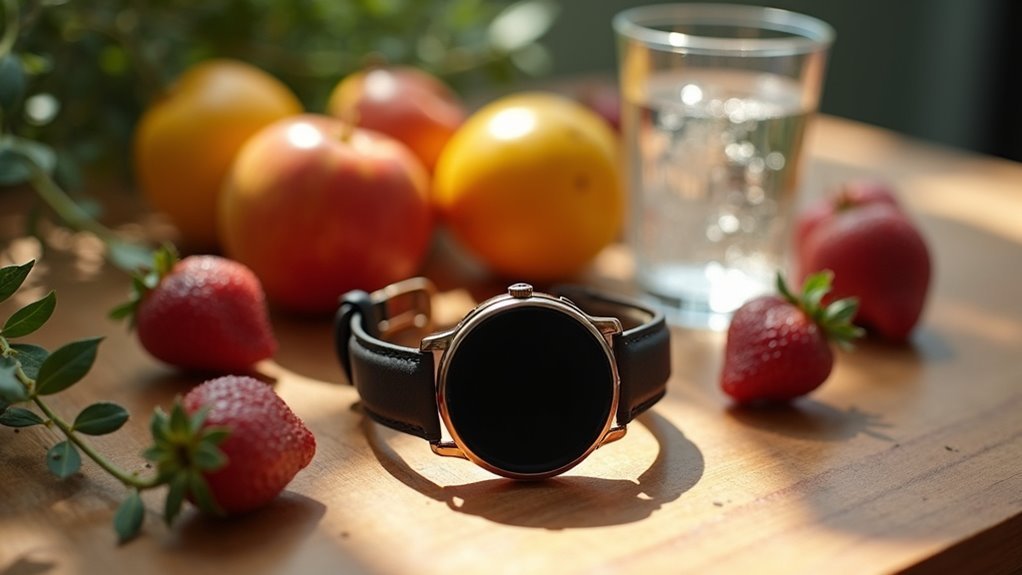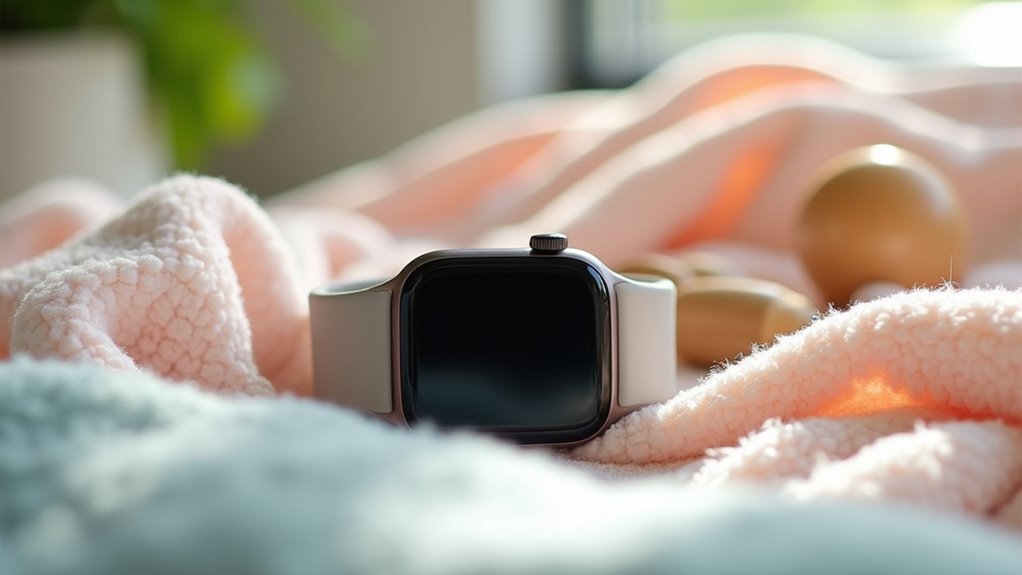You can detect sleep apnea at home using five advanced wearables: Apple Watch monitors breathing interruptions through its accelerometer, detecting 89% of severe cases; Samsung Galaxy Watch offers FDA-approved monitoring for adults 22+ requiring twice-weekly tracking; AcuPebble analyzes respiratory sounds via neck-worn sensors; wearable patches achieve 88.5% detection rates while headbands average 71%; and AI-powered devices deliver 86.9% accuracy with clinical-grade precision. These technologies eliminate expensive lab visits while providing reliable monitoring for better sleep health insights.
Apple Watch Sleep Apnea Detection Capabilities
While many wearable devices claim to monitor sleep patterns, Apple’s Watch stands out with its sophisticated sleep apnea detection system that targets adults 18 and older who haven’t been previously diagnosed with the condition.
The device operates through two distinct layers: nightly tracking and thorough 30-day assessments that review breathing disturbance patterns.
You’ll find the Apple Watch monitors breathing interruptions that correlate with apnea and hypopnea events, though it doesn’t use blood oxygen levels for detection. The watch utilizes its built-in accelerometer to identify these breathing disturbances throughout the night.
The system’s accuracy varies considerably—detecting about 89% of severe sleep apnea cases but only 43% of moderate cases.
After opting into the feature, you’ll receive notifications if consistent elevations suggest moderate to severe sleep apnea, enabling up to 12 annual assessments.
Samsung Galaxy Watch FDA-Approved Monitoring System
Samsung’s Galaxy Watch earned a significant regulatory milestone when it became the first wearable to receive De Novo authorization from the FDA for sleep apnea detection, targeting adults over 22 who haven’t received a previous sleep apnea diagnosis.
You’ll need a compatible Galaxy Watch and phone with the Samsung Health Monitor app to access this feature.
The system detects moderate to severe obstructive sleep apnea by monitoring breathing disruptions through built-in sensors.
You must track your sleep twice for over four hours within a 10-day period for effective detection.
The feature analyzes your sleep data and displays results through the watch’s user-friendly interface, though it’s not intended to replace clinical diagnosis or treatment by healthcare professionals. Early detection is crucial since untreated sleep apnea significantly increases the risk of cardiovascular diseases including hypertension, heart failure, and stroke.
AcuPebble Specialized Respiratory Sound Analysis
AcuPebble takes a different approach to sleep apnea detection by analyzing respiratory and cardiac sounds through a specialized neck-worn sensor. You’ll attach the SA100 device at your neck’s base, where it captures acoustic signals from your respiratory and cardiac functions.
The sensor wirelessly transmits recorded body sounds to your mobile device for automated analysis. You’ll benefit from clinically validated algorithms that meet AASM standards for diagnostic accuracy.
The companion app provides step-by-step guidance through its patient portal, while healthcare providers use the HCP portal to set up studies and review results remotely. This CE-marked medical device enables complete at-home sleep testing without uncomfortable lab procedures. The system delivers 100% usability with all patients able to complete testing without any training required.
Beyond sleep apnea, you can use AcuPebble’s technology for monitoring other respiratory conditions like COPD and asthma.
Wearable Patches and Headband Sleep Trackers
Beyond neck-worn acoustic sensors, wearable patches and headband trackers offer another convenient approach to sleep apnea monitoring from your bedroom.
These devices eliminate overnight hospital stays while you sleep naturally at home.
Wearable patches represent a breakthrough in accuracy, achieving 88.5% detection rates compared to headband devices’ 71% average. They simultaneously monitor brain activity, eye movements, and muscle tone through embedded sensors that wirelessly transmit data to your smartphone.
Key advantages that’ll transform your sleep health:
- No more uncomfortable sleep lab visits – Monitor your condition in your own comfortable bed
- AI-powered early detection – Catch sleep apnea before symptoms worsen your health
- Seamless daily integration – Thin, soft patches won’t disrupt your sleep routine
Consumer headbands like Fitbit and Apple Watch provide general sleep tracking but lack clinical-grade apnea detection capabilities. Traditional sleep lab testing can cost approximately $8,000 per person per night, making these affordable wearable alternatives particularly attractive for widespread screening.
AI-Powered Detection Accuracy and Clinical Validation
While traditional sleep studies require expensive overnight lab visits, AI-powered wearables now deliver clinical-grade accuracy that rivals professional polysomnography. You’ll find these devices achieve impressive metrics: 86.9% pooled accuracy, 93.8% sensitivity, and 75.2% specificity for apnea detection. Advanced ECG-based AI models reach 99.56% success rates while protecting your privacy through encrypted data processing. Researchers from University at Buffalo developed this breakthrough technology over two years, demonstrating that complex deep learning operations can be performed on fully encrypted medical data.
| Detection Method | Accuracy | Clinical Impact |
|---|---|---|
| Wearable AI | 86.9% | Real-time monitoring |
| ECG Encrypted AI | 99.56% | Privacy protection |
| SpO₂ AI Screening | 89% | Home accessibility |
| Severity Classification | 65.1% | Treatment optimization |
| Apnea Type Differentiation | 81.5% | Targeted therapy |
These validated models enable earlier intervention, better treatment decisions, and improved outcomes without compromising your comfort or privacy.
Frequently Asked Questions
How Much Do Wearable Sleep Apnea Detection Devices Typically Cost?
You’ll pay $30-$800+ for wearable sleep apnea detection devices, depending on type. Basic wrist trackers start around $30, while smartwatches range $100-$800+. Don’t forget potential monthly subscription fees of $5.99-$30.
Can Children and Teenagers Safely Use These Wearable Sleep Monitoring Devices?
You can safely use wearable sleep monitors as a teenager, but they’re not recommended for healthy children. Proper sensor placement and medical guidance are essential, especially if you have existing health conditions.
Do Insurance Companies Cover Wearable Devices for Sleep Apnea Screening Purposes?
Insurance companies generally don’t cover wearable devices for sleep apnea screening since they’re not FDA-approved diagnostic tools. However, you might find coverage if they’re part of a physician-directed pathway.
How Long Does the Battery Last on Sleep Tracking Wearables?
Sleep tracking wearables’ battery life varies considerably. You’ll get 4-7 days from Oura Ring, up to 14 days from Whoop 4.0, and around 4-5 days from Fitbit Versa 4, depending on usage.
Are There Any Side Effects From Wearing Sleep Monitors Nightly?
You might experience skin irritation, anxiety from obsessing over data, or disrupted sleep from screen exposure. Some people develop orthosomnia, becoming overly preoccupied with tracker results, which can worsen sleep quality.





Leave a Reply